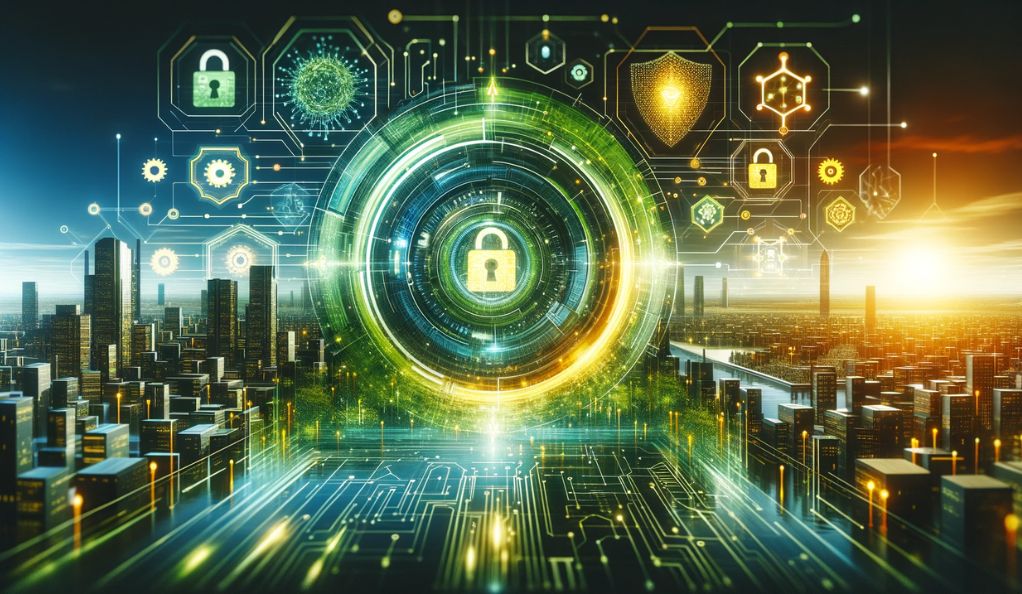Augmented Reality (AR): A Brief Overview
Augmented Reality, commonly referred to as AR, is a technology that overlays digital information—such as images, sounds, or other data—onto the real world. Unlike Virtual Reality (VR) which immerses users in a completely virtual environment, AR integrates and enhances our real-world experience with virtual elements. This integration is achieved using various devices, including smartphones, tablets, and specialized AR glasses.
The Significance of AR in the Cybersecurity Landscape
In today’s digital age, cybersecurity has become paramount. With the increasing number of cyber threats and attacks, there’s a pressing need for innovative solutions to protect sensitive data and maintain the integrity of digital systems. This is where Augmented Reality steps in.
AR’s ability to overlay digital information onto the real world offers unique opportunities in the realm of cybersecurity. For instance, imagine a security analyst visualizing a network’s vulnerabilities in real-time, with threats highlighted in their physical workspace. Or consider a training scenario where budding cybersecurity professionals can practice their skills in a real-world setting, enhanced with virtual cyberattacks.
Why AR Matters in Cybersecurity
- Enhanced Visualization: Traditional cybersecurity tools often present data in complex charts or logs. AR can transform this data into intuitive visual representations, making it easier for analysts to identify and address potential threats.
- Real-time Response: With AR, security professionals can receive real-time alerts and guidance on potential threats, ensuring swift and effective responses.
- Training & Awareness: AR can simulate cyberattacks in a real-world environment, providing hands-on training experiences that are both engaging and educational.
Threat Visualization with AR
The Traditional Challenge of Cyber Threat Visualization
In the realm of cybersecurity, understanding and interpreting threats is a complex task. Traditional methods often involve sifting through vast amounts of log data, analyzing charts, and interpreting complex patterns. This process can be time-consuming and requires a high level of expertise.
| Criteria | Traditional Methods | AR-enhanced Methods |
|---|---|---|
| Data Presentation | Text-based logs, static charts | Dynamic, interactive visual overlays |
| User Engagement | Requires focused analysis, can be tedious | Intuitive, immersive experience |
| Speed of Interpretation | Can be slow due to data complexity | Faster due to visual cues and real-time data representation |
| Accessibility | Limited to specific software or platforms | Accessible across various devices, including AR glasses and mobile devices |
How AR Enhances Threat Visualization
Augmented Reality transforms the way security analysts perceive and interact with threat data. Here’s how:
- Intuitive Overlays: AR can overlay threat information directly onto physical devices or network diagrams. For instance, a server displaying a red hologram could indicate a potential vulnerability, while a green one might signify secure status.
- Interactive Data Interaction: Instead of passively viewing data, analysts can interact with AR visualizations. This could mean zooming into a specific data point, isolating a potential threat vector, or even simulating potential attack outcomes.
- Contextual Insights: AR can provide contextual information about threats. For example, pointing an AR device at a network node might display its current status, historical threat data, and recommended mitigation strategies.
Real-world Applications of AR in Threat Visualization
Several organizations are already harnessing the power of AR for threat visualization:
Network Monitoring: Companies with large-scale networks can use AR to monitor network traffic. By wearing AR glasses, IT professionals can walk through server rooms and instantly see which servers are experiencing high traffic, potential threats, or failures.
Incident Response: In the event of a security breach, AR can guide incident response teams with visual cues, highlighting affected systems and providing step-by-step remediation instructions.
Strategic Planning: When planning cybersecurity strategies, AR can help teams visualize potential threat vectors, assess vulnerabilities, and prioritize defense mechanisms.
Real-Time Monitoring and AR
The Evolution of Real-Time Monitoring
Real-time monitoring in cybersecurity refers to the continuous observation and analysis of a system or network to detect and address potential threats as they occur. Traditional monitoring tools provide a dashboard view, often cluttered with data, making it challenging to discern critical alerts from routine notifications.
AR’s Transformative Impact on Real-Time Monitoring
Augmented Reality brings a paradigm shift to real-time monitoring in the following ways:
Spatial Awareness: AR provides a spatial representation of data. For instance, in a data center, AR can highlight the exact rack or server experiencing an issue, guiding technicians directly to the source of the problem.
Priority-based Alerts: Instead of a barrage of notifications, AR can display alerts based on their severity. Critical threats might be represented as flashing red holograms, while routine notifications could be more subdued.
Contextual Data: Hovering over an alert with an AR device can provide additional information, such as the nature of the threat, its origin, and recommended mitigation steps.
Immersive Training and Simulations

The Need for Hands-on Cybersecurity Training
In the ever-evolving landscape of cyber threats, theoretical knowledge alone is insufficient. Cybersecurity professionals must be equipped with practical skills, honed through realistic simulations and hands-on training. Traditional training methods, while effective, often lack the immersive experience that can prepare individuals for real-world cyber incidents.
| Criteria | Traditional Training | AR-enhanced Training |
|---|---|---|
| Engagement | Classroom-based, online modules | Interactive, immersive scenarios |
| Realism | Simulated environments, limited real-world feel | Authentic replication of real-world cyber incidents |
| Flexibility | Fixed scenarios, limited variability | Dynamic scenarios, adaptable in real-time |
| Feedback | Post-training assessments | Instantaneous feedback during simulations |
AR: Revolutionizing Cybersecurity Training
Augmented Reality offers a transformative approach to cybersecurity training:
- Real-world Scenarios: With AR, trainees can experience cyberattacks as they would unfold in real life. For instance, a trainee might witness a live phishing attack on a virtual email system, complete with real-time alerts and notifications.
- Interactive Learning: AR provides an interactive platform where trainees can engage directly with simulated threats. They can practice their response strategies, test out different solutions, and receive immediate feedback on their actions.
- Customizable Simulations: AR training modules can be tailored to suit individual or organizational needs. Whether it’s a beginner-level session on malware detection or an advanced module on threat mitigation, AR can adapt to varied training requirements.
Enhancing Physical Security through AR
The Intersection of Physical and Cybersecurity
While cybersecurity primarily focuses on protecting digital assets, it’s intrinsically linked with physical security. Unauthorized physical access to servers, workstations, or network infrastructure can lead to significant cyber vulnerabilities. As organizations grow and expand their physical footprints, ensuring the security of both digital and physical realms becomes paramount.
AR’s Role in Elevating Physical Security
Augmented Reality offers innovative solutions to enhance traditional physical security measures:
Real-time Information Overlay: Security personnel wearing AR glasses can instantly access information about individuals entering a facility, verifying their credentials against a database and highlighting any discrepancies.
Guided Response: In case of security breaches, AR can guide security staff with visual cues, leading them directly to the source of the breach or to individuals of interest.
Enhanced Surveillance: AR can augment CCTV feeds, highlighting areas of interest, tracking movement patterns, and even predicting potential security threats based on analyzed patterns.
Interactive Access Control: Beyond traditional ID cards or biometrics, AR can be used for advanced access control. For instance, facial recognition data captured through AR devices can be cross-referenced with employee databases, ensuring only authorized personnel gain access.
Advanced Access Control and Authentication

The Pillars of Access Control
Access control is a cornerstone of cybersecurity, ensuring that only authorized individuals can access specific resources. Traditional access control mechanisms, such as passwords, PINs, and biometric systems, have served us well. However, as cyber threats evolve, there’s a need for more advanced, secure, and user-friendly authentication methods.
AR’s Role in Reinventing Access Control
Augmented Reality offers a fresh perspective on access control, introducing innovative methods that are both secure and user-centric:
Spatial Authentication: AR can recognize where a user is physically located. For instance, accessing a confidential file might require the user to be in a specific room or location, verified through AR.
Gesture-based Controls: With AR, gestures can become passwords. A specific hand movement or a sequence of gestures can be set as an authentication method, recognized and verified through AR devices.
Visual Tokens: Instead of traditional OTPs (One-Time Passwords), AR can generate visual tokens—patterns, symbols, or sequences—that users must recognize and replicate for authentication.
Multi-factor Authentication: AR can seamlessly integrate multiple authentication methods. For example, facial recognition (biometric) combined with a specific gesture (behavioral) ensures a higher level of security.
Data Visualization and AR
The Complexity of Cybersecurity Data
Cybersecurity generates vast amounts of data. From network traffic logs to threat intelligence feeds, the sheer volume and complexity of this data can be overwhelming. Traditional data visualization tools, such as graphs, charts, and heat maps, offer a visual representation, but they often fall short in conveying the depth and intricacies of cybersecurity data.
AR: A New Paradigm in Data Visualization
Augmented Reality introduces a transformative approach to data visualization:
Spatial Data Representation: AR allows for the visualization of data in a three-dimensional space. For instance, a network’s data flow can be visualized as streams of light, with thicker streams indicating higher traffic.
Real-time Interaction: Users can interact directly with AR visualizations. This could involve isolating a specific data point, exploring a potential vulnerability, or even simulating the impact of a hypothetical threat.
Layered Information: AR can overlay multiple layers of data, providing a comprehensive view. For example, a map of global cyber threats can be overlaid with real-time threat intelligence, historical data, and predictive analytics.
Personalized Insights: AR visualizations can adapt to the user’s needs, highlighting relevant data points and offering personalized insights based on the user’s role, preferences, and past interactions.
Conclusion
As the digital landscape becomes increasingly complex, the need for effective cybersecurity training and awareness has never been more paramount. Augmented Reality (AR) emerges as a game-changer in this domain. By overlaying virtual elements onto the real world, AR provides an immersive and interactive platform for cybersecurity education. Trainees can experience real-world cyber threats in controlled environments, enhancing their understanding and response capabilities. Moreover, AR fosters heightened awareness by visualizing abstract cyber concepts, making them tangible and relatable. In essence, AR not only equips individuals with the skills to combat cyber threats but also cultivates a culture of proactive cybersecurity awareness. As we navigate the future of digital security, the integration of AR in training and awareness initiatives promises a more informed and resilient cyber landscape.








